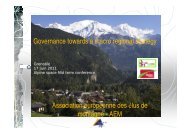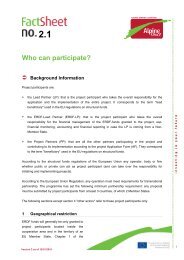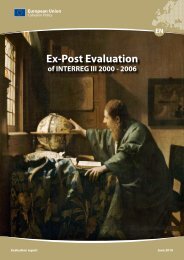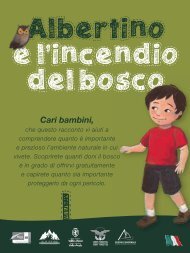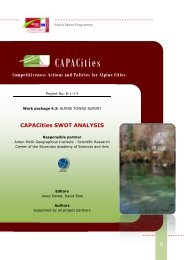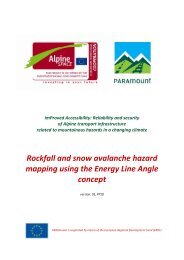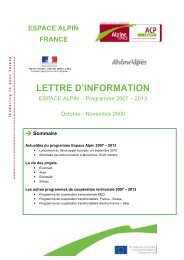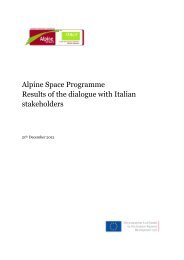aDaptation strategies to spatial planning anD regional Development
aDaptation strategies to spatial planning anD regional Development
aDaptation strategies to spatial planning anD regional Development
You also want an ePaper? Increase the reach of your titles
YUMPU automatically turns print PDFs into web optimized ePapers that Google loves.
Model Region “Au<strong>to</strong>nomous<br />
Region of Aosta Valley”<br />
18<br />
Immigration<br />
Social inclusion<br />
l<br />
Aosta Valley is composed of 74<br />
area size<br />
municipalities grouped area size in<strong>to</strong> 8<br />
seniors per child<br />
population<br />
seniors per child<br />
Mountain Communities, except<br />
for Aosta, seniors which is the county<br />
population density<br />
seniors<br />
<strong>to</strong>wn. It is located in the northwest<br />
workforceof Italy on the border with<br />
workforce<br />
France and Switzerland.<br />
children<br />
children<br />
population<br />
Size: 3.263,25 km²<br />
births<br />
apartment size<br />
Inhabitants: 128,230 births(2011)<br />
household size<br />
household size<br />
Density of Population: 39,3 Inh./km²<br />
economic strength<br />
economic strength<br />
unemployment<br />
apartment size<br />
population density<br />
unemployment<br />
DEMOCHANGE model regions average<br />
DEMOCHANGE model regions average<br />
District of Garmisch-Partenkirchen (D)<br />
District of Garmisch-Partenkirchen (D)<br />
Note: indica<strong>to</strong>r "unemployment" relates <strong>to</strong> the next-higher administrative level<br />
Note: indica<strong>to</strong>r "unemployment" relates <strong>to</strong> the next-higher administrative level<br />
l<br />
area size<br />
seniors per child<br />
seniors per child<br />
seniors<br />
workforce<br />
children<br />
workforce<br />
births<br />
seniors<br />
children<br />
area size<br />
population<br />
apartment size<br />
births<br />
household size<br />
household size<br />
area size<br />
area size<br />
seniors per child<br />
population<br />
seniors per child<br />
Foreign citizens<br />
population<br />
population density<br />
population density<br />
economic strength<br />
economic strength<br />
unemployment<br />
apartment size<br />
unemployment<br />
DEMOCHANGE model regions average<br />
DEMOCHANGE model regions average<br />
Aosta Valley region (I)<br />
Aosta Valley region (I)<br />
Note: some indica<strong>to</strong>rs relate <strong>to</strong> the next-higher administrative level<br />
Note: some indica<strong>to</strong>rs relate <strong>to</strong> the next-higher administrative level<br />
population<br />
10.000<br />
seniors<br />
seniors<br />
population density<br />
population density<br />
9.000<br />
8.000<br />
7.000<br />
6.000<br />
workforce<br />
5.000<br />
workforce<br />
economic strength<br />
economic strength<br />
4.000<br />
3.000<br />
children<br />
children<br />
unemployment<br />
unemployment<br />
2.000<br />
1.000<br />
0<br />
1996 births 1997 2001 2002<br />
births<br />
apartment 2004 2005 2006 size 2007 2008 2009 2010 2011<br />
apartment size<br />
1993 1994 1995 1998 1999 2000 2003<br />
household size<br />
household size<br />
DEMOCHANGE model regions average<br />
DEMOCHANGE model regions average<br />
South Tyrolean Model Region (I)<br />
South Tyrolean Model Region (I)<br />
Note: some indica<strong>to</strong>rs relate <strong>to</strong> the next-higher administrative level<br />
Note: some indica<strong>to</strong>rs relate <strong>to</strong> the next-higher administrative level<br />
VALLE D’AOSTA - Pra<strong>to</strong> di S.Orso e Gran Paradiso Cogne (pho<strong>to</strong>: Kondo)<br />
Pilot Actions<br />
Title: Services, Sensors of<br />
Immigrants’ Integration (SSII)<br />
Objective: Creation of a<br />
moni<strong>to</strong>ring system for the<br />
integration of immigrants in<br />
Aosta Valley.<br />
Description: The moni<strong>to</strong>ring<br />
system was created<br />
by involving <strong>regional</strong><br />
welfare services and the 7<br />
municipalities with the highest<br />
number of immigrants. Data<br />
was collected for systematic<br />
and synchronic analysis and<br />
then organised in<strong>to</strong> 3 main<br />
areas of integration: public and<br />
civil ; cultural and religious;<br />
economic and social. These<br />
areas have been crossanalysed<br />
at 3 levels and<br />
regard the following: norms<br />
and policies; opportunities and<br />
actual conditions; perception<br />
and identity. The concept of<br />
integration, and accordingly<br />
data sets are intended as exact<br />
pairs for immigrants as well as<br />
for the local population.<br />
The impact of the pilot action<br />
is positive on many grounds.<br />
1. it has supported the<br />
establishment of a network<br />
connecting services and<br />
councils aimed at carrying<br />
out common analysis on the<br />
immigration phenomenon and<br />
supporting integrated policies.<br />
2. a web site that includes<br />
updated data sets and cross<br />
institutional analysis has been<br />
set up for services <strong>to</strong> be able <strong>to</strong><br />
constantly moni<strong>to</strong>r integration;<br />
3. the first pilot edition of a<br />
summer school on the <strong>to</strong>pic<br />
is planned in Aosta Valley for<br />
September 2012, involving<br />
stakeholders and academics at<br />
national level.<br />
Transferability: The pilot<br />
action can be easily transferred<br />
<strong>to</strong> other Alpine regions.<br />
Responsible Project Partner:<br />
Dario Ceccarelli<br />
statistica@statistica.vda.it



